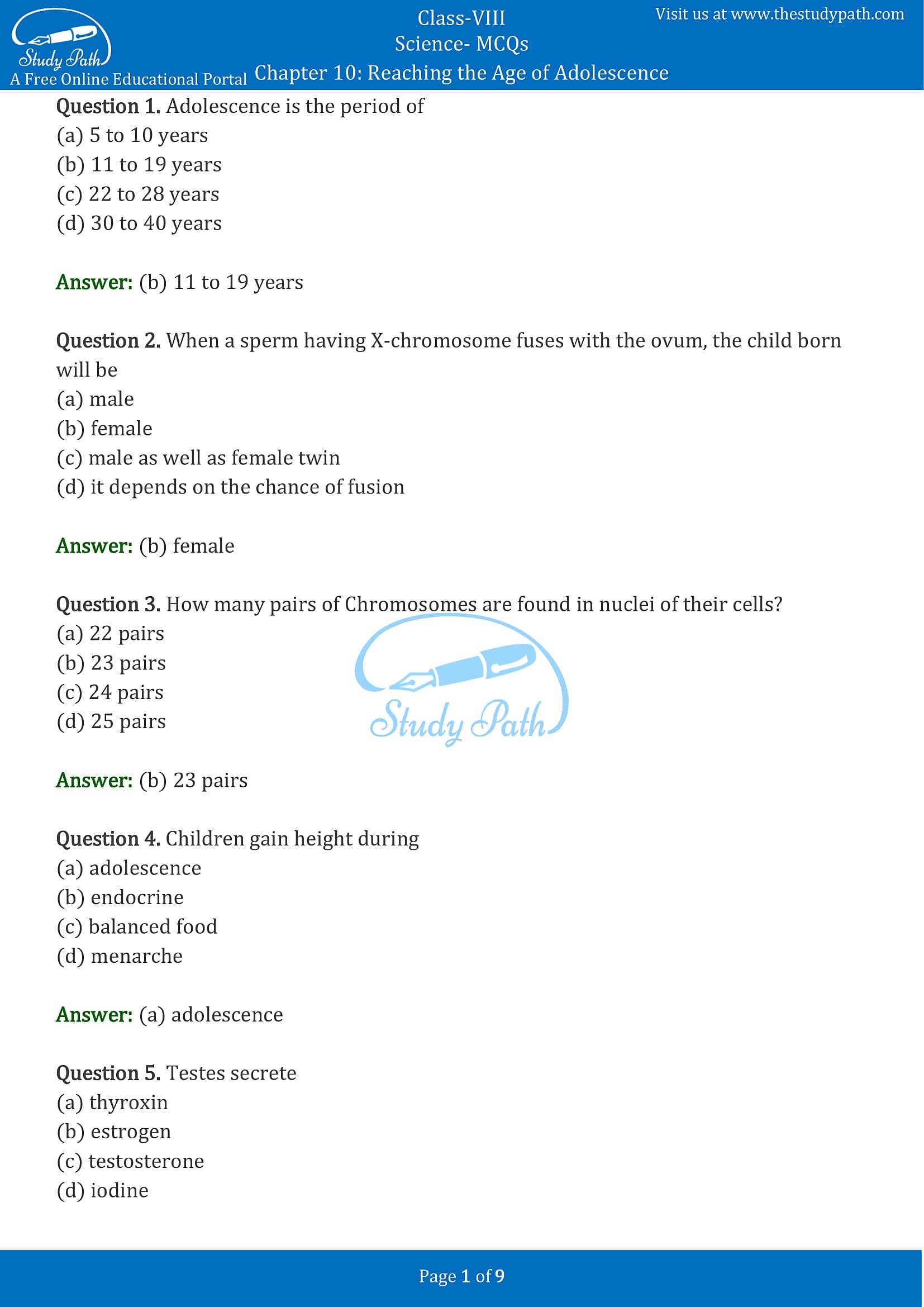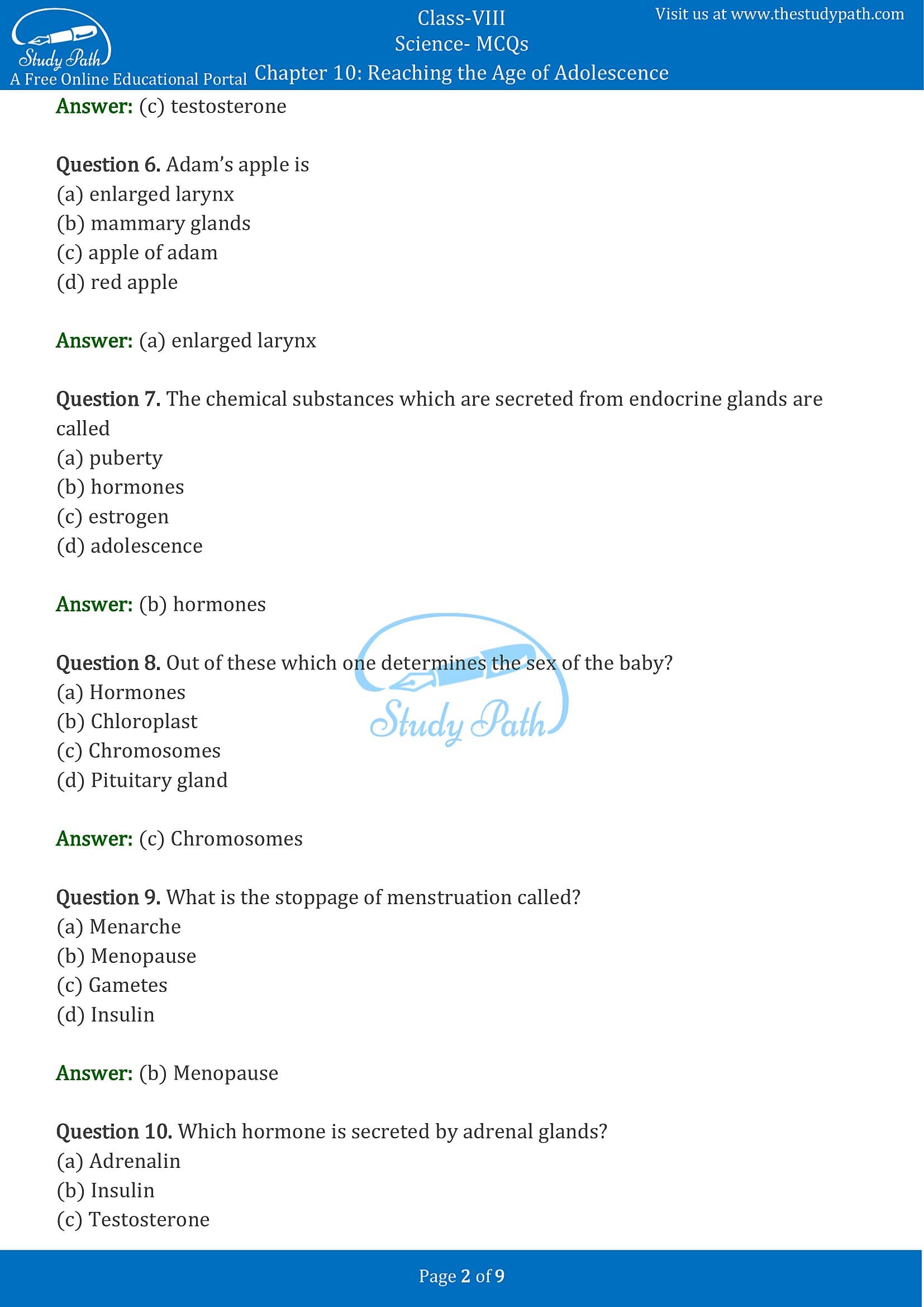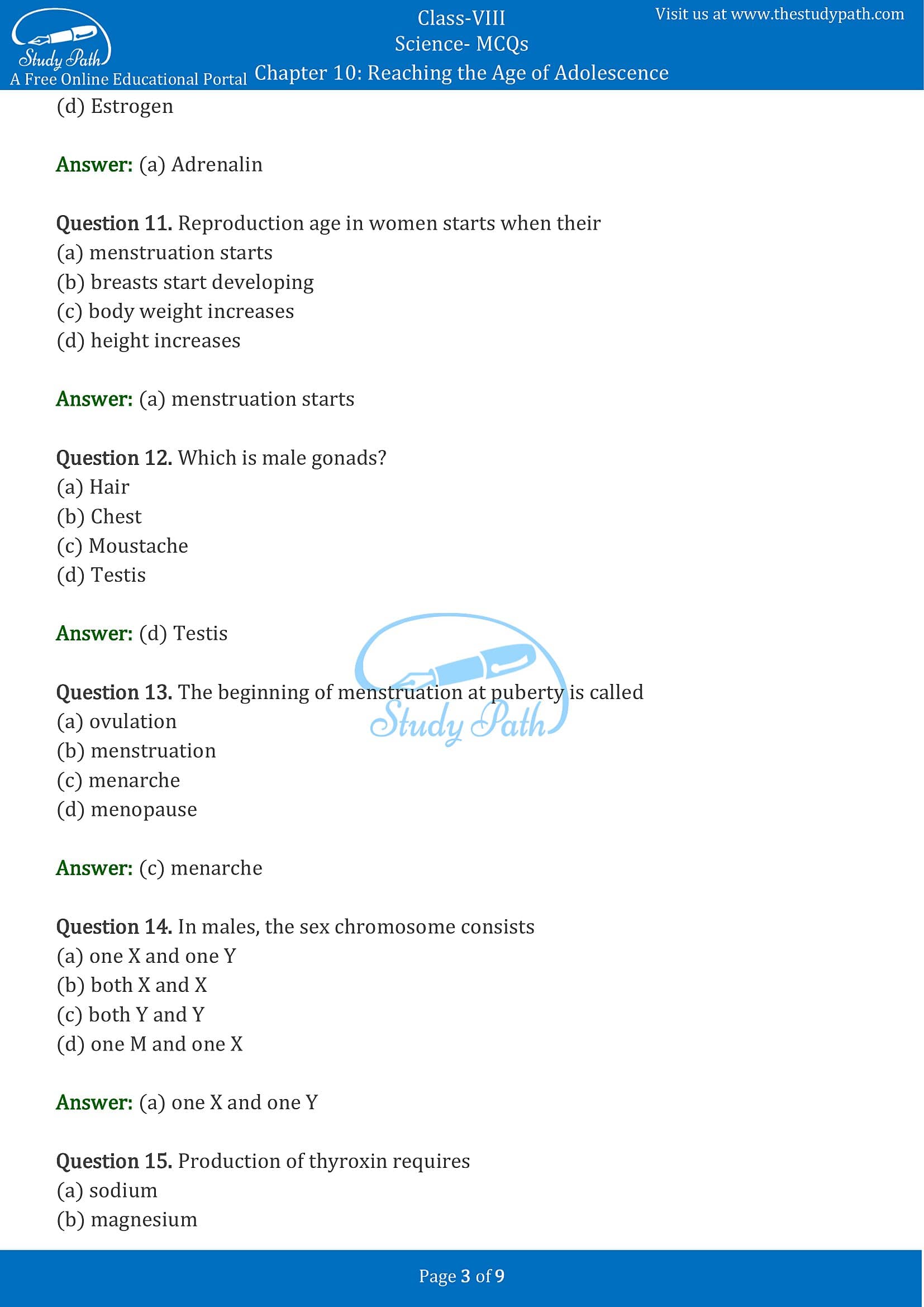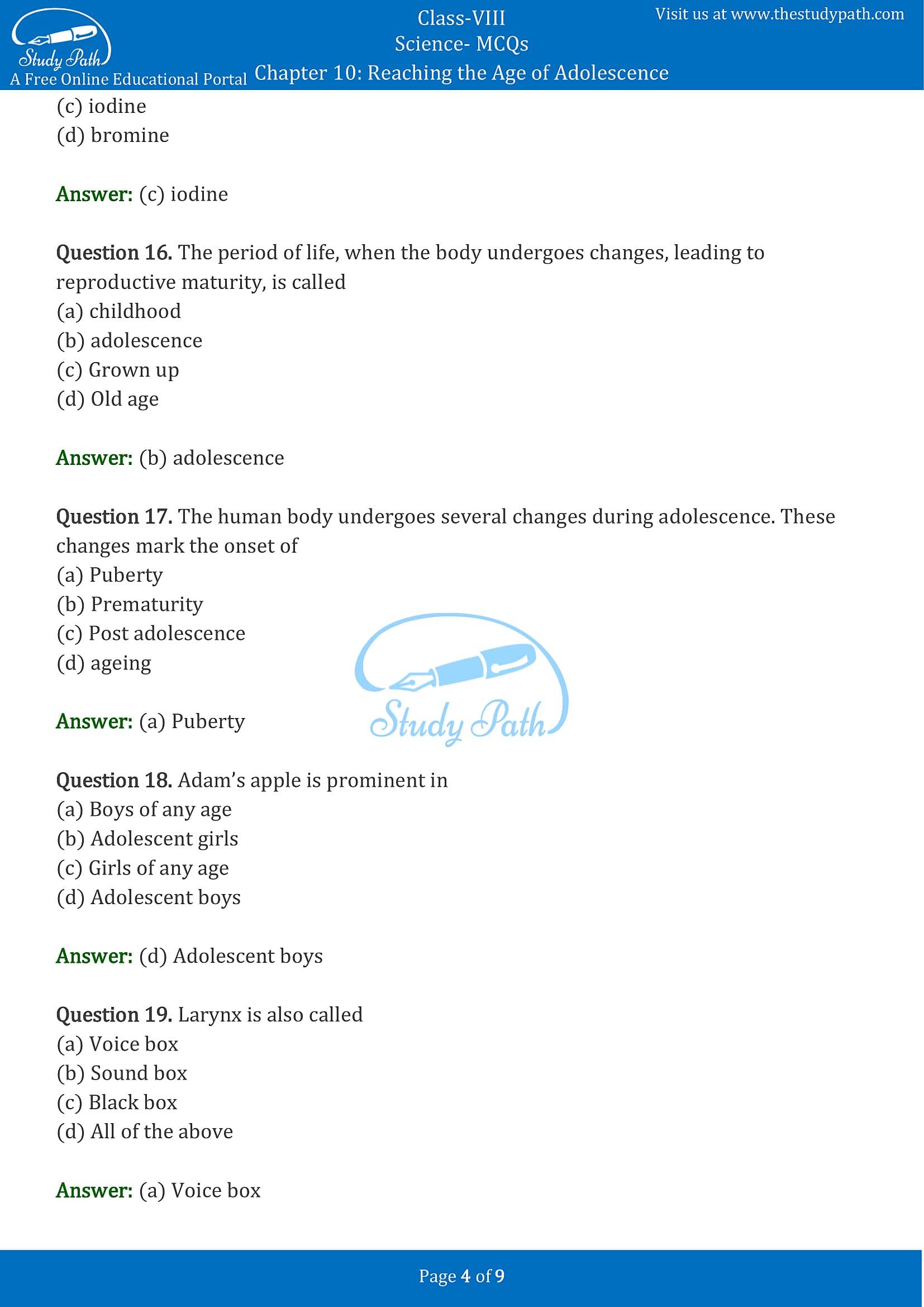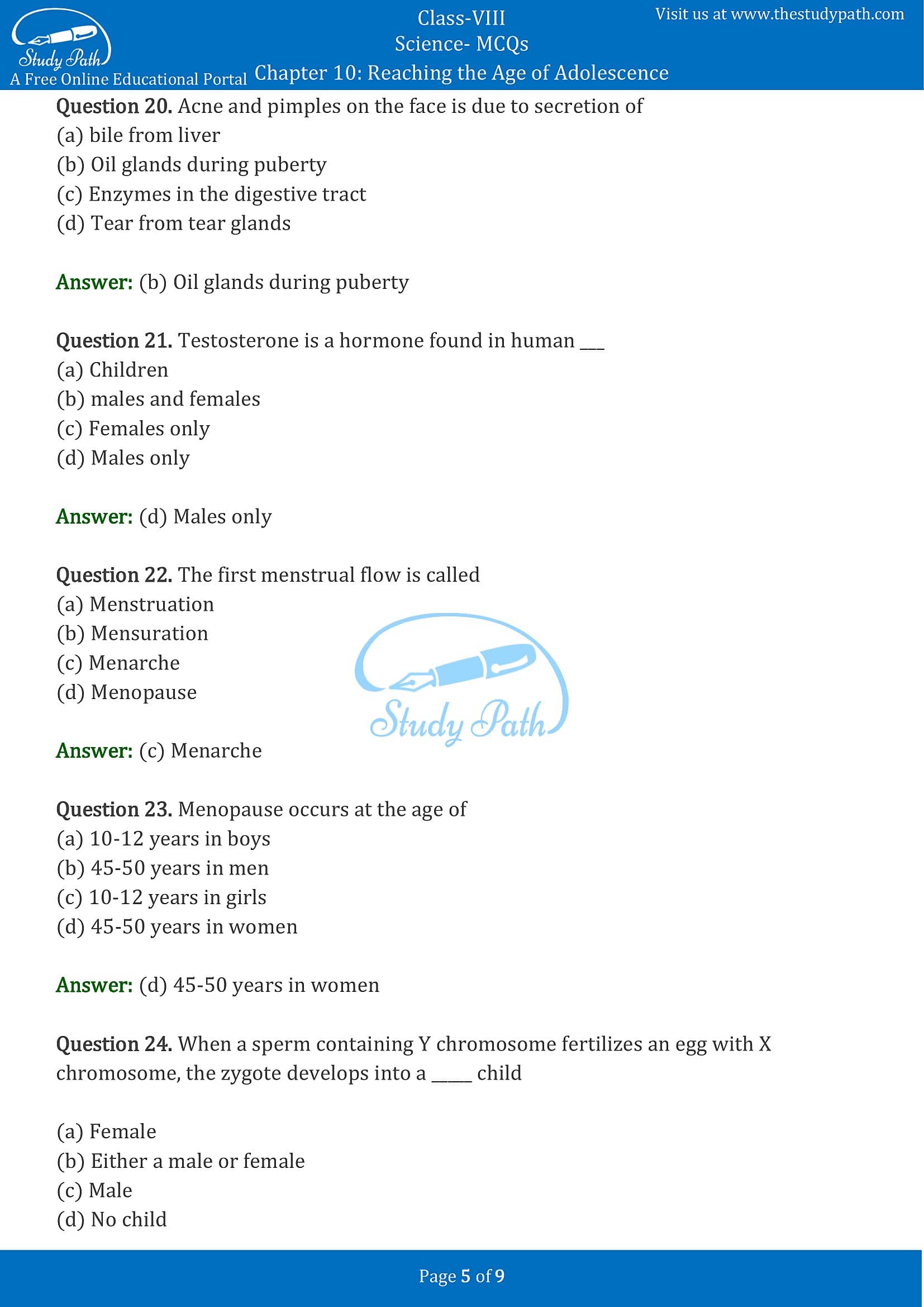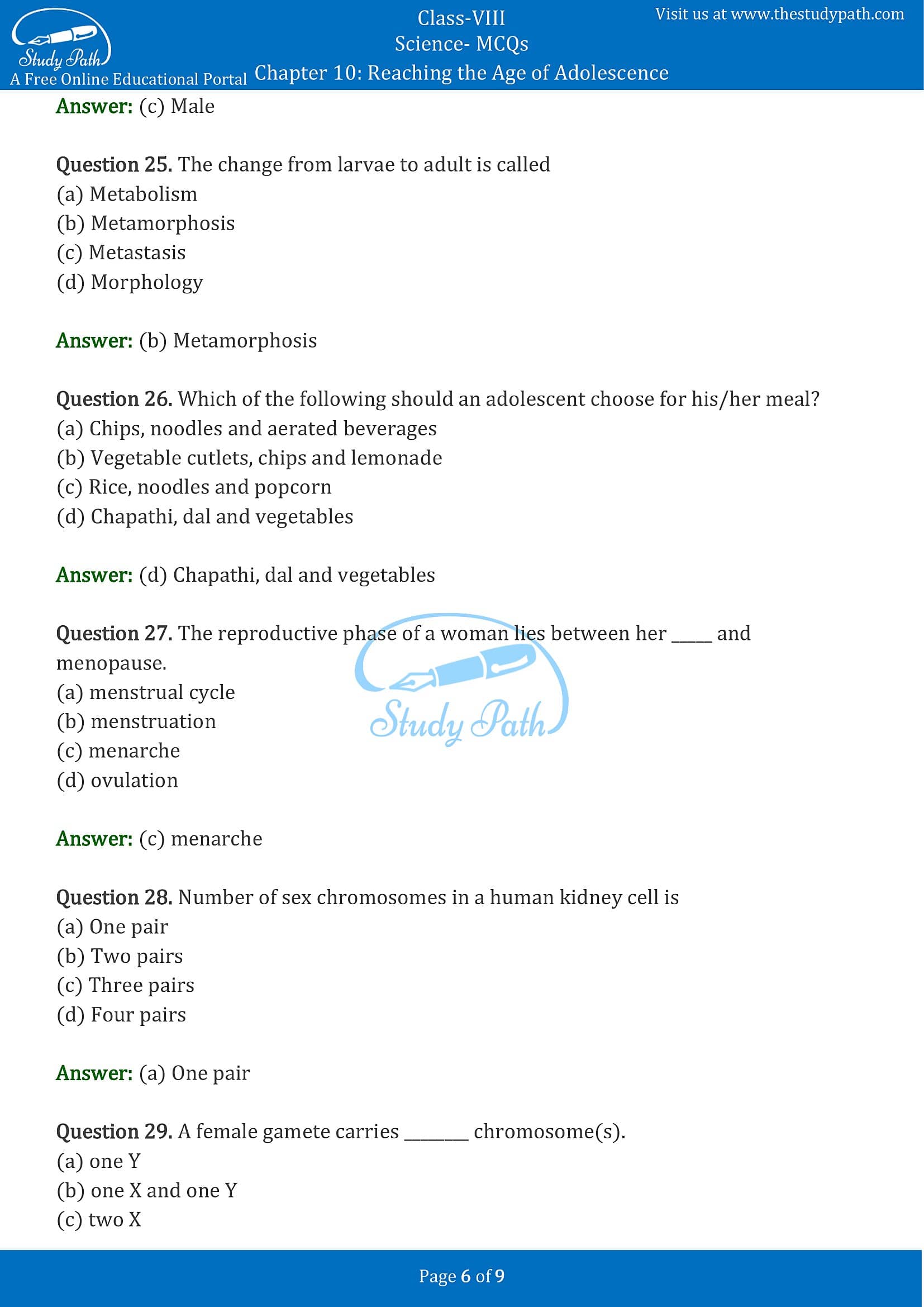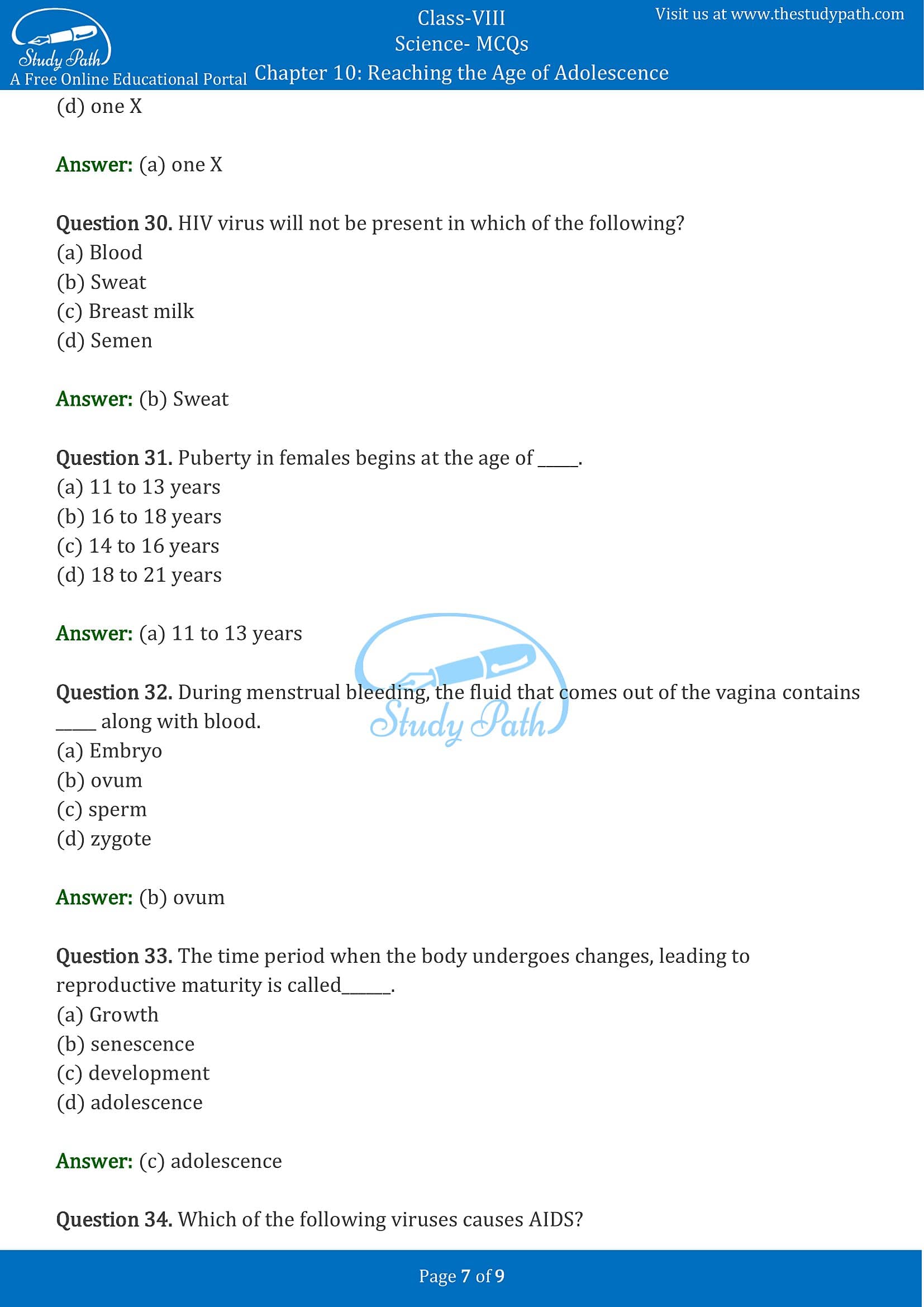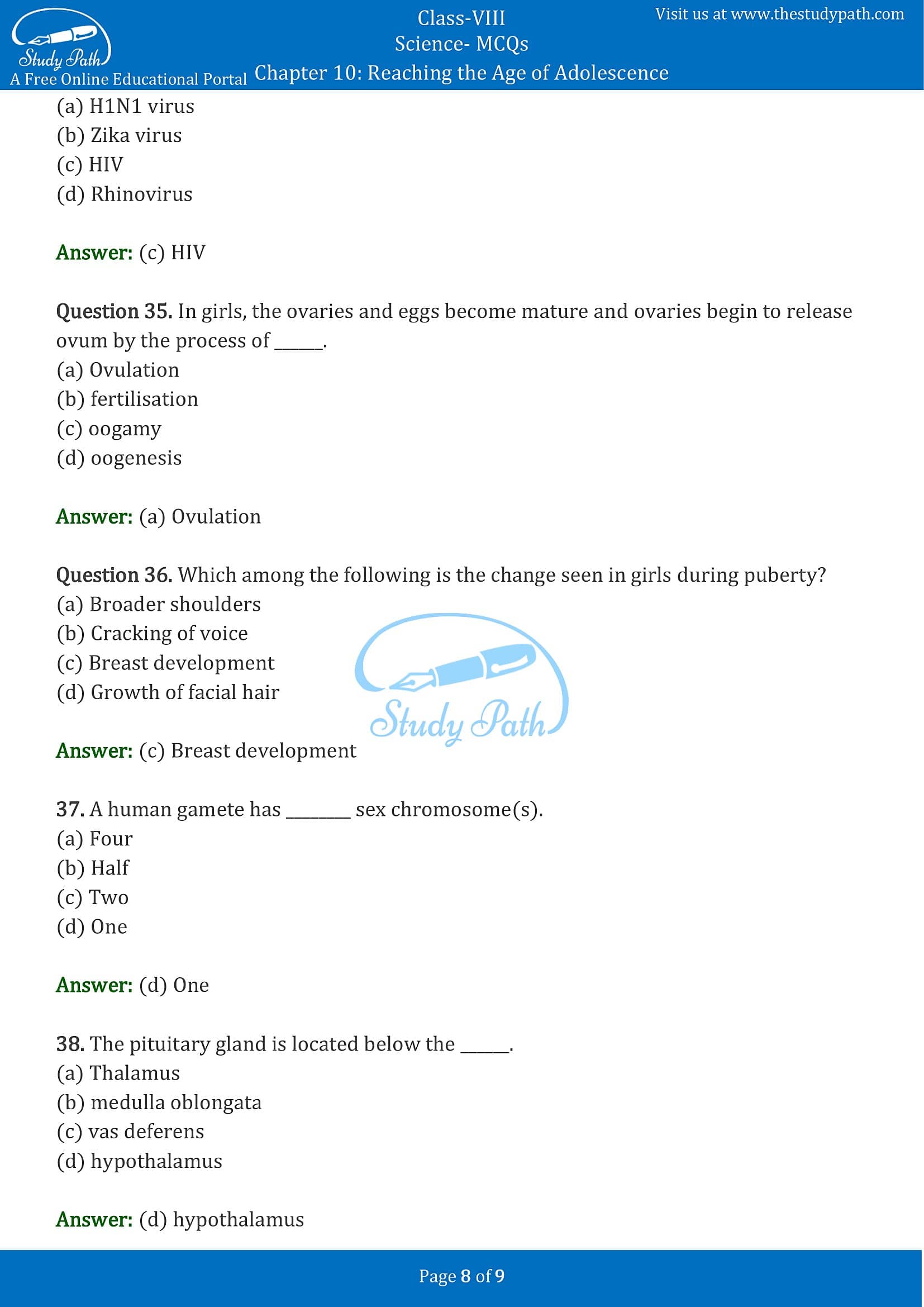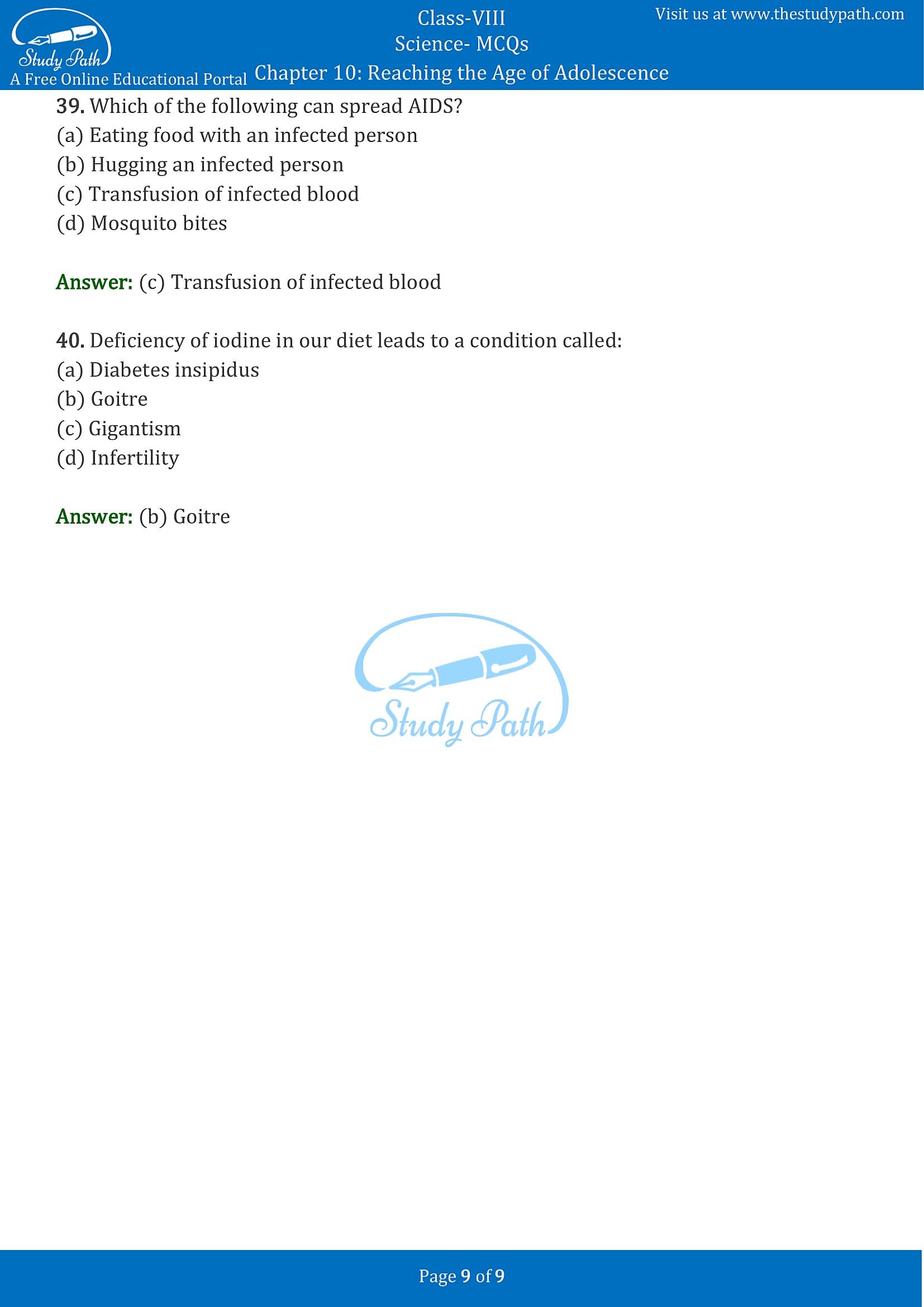Class 8 Science Chapter 10 Reaching the Age of Adolescence MCQ with Answers
Class 8 Science Chapter 10 Reaching the Age of Adolescence MCQ (Multiple Choice Questions) with Answers is available here in PDF format. CBSE Class 8 Science Reaching the Age of Adolescence Objective Questions helps the students to understand the concepts thoroughly and to score good marks. Practising these MCQs will help you to answer every question that is being asked in the exams.
At Study Path, you can download PDF of Multiple Choice Questions for Class 8 Chapter 10 Reaching the Age of Adolescence with Answers. Our expert teachers prepared these MCQs on the basis latest exam Pattern. Students can solve these NCERT MCQs before the exam to know their preparation level.
Reaching the Age of Adolescence Class 8 MCQ with Answers
Multiple Choice Questions (MCQs)
Question 1. Adolescence is the period of
(a) 5 to 10 years
(b) 11 to 19 years
(c) 22 to 28 years
(d) 30 to 40 years
Answer: (b) 11 to 19 years
Question 2. When a sperm having X-chromosome fuses with the ovum, the child born will be
(a) male
(b) female
(c) male as well as female twin
(d) it depends on the chance of fusion
Answer: (b) female
Question 3. How many pairs of Chromosomes are found in nuclei of their cells?
(a) 22 pairs
(b) 23 pairs
(c) 24 pairs
(d) 25 pairs
Answer: (b) 23 pairs
Question 4. Children gain height during
(a) adolescence
(b) endocrine
(c) balanced food
(d) menarche
Answer: (a) adolescence
Question 5. Testes secrete
(a) thyroxin
(b) estrogen
(c) testosterone
(d) iodine
Answer: (c) testosterone
Question 6. Adam’s apple is
(a) enlarged larynx
(b) mammary glands
(c) apple of adam
(d) red apple
Answer: (a) enlarged larynx
Question 7. The chemical substances which are secreted from endocrine glands are called
(a) puberty
(b) hormones
(c) estrogen
(d) adolescence
Answer: (b) hormones
Question 8. Out of these which one determines the sex of the baby?
(a) Hormones
(b) Chloroplast
(c) Chromosomes
(d) Pituitary gland
Answer: (c) Chromosomes
Question 9. What is the stoppage of menstruation called?
(a) Menarche
(b) Menopause
(c) Gametes
(d) Insulin
Answer: (b) Menopause
Question 10. Which hormone is secreted by adrenal glands?
(a) Adrenalin
(b) Insulin
(c) Testosterone
(d) Estrogen
Answer: (a) Adrenalin
Question 11. Reproduction age in women starts when their
(a) menstruation starts
(b) breasts start developing
(c) body weight increases
(d) height increases
Answer: (a) menstruation starts
Question 12. Which is male gonads?
(a) Hair
(b) Chest
(c) Moustache
(d) Testis
Answer: (d) Testis
Question 13. The beginning of menstruation at puberty is called
(a) ovulation
(b) menstruation
(c) menarche
(d) menopause
Answer: (c) menarche
Question 14. In males, the sex chromosome consists
(a) one X and one Y
(b) both X and X
(c) both Y and Y
(d) one M and one X
Answer: (a) one X and one Y
Question 15. Production of thyroxin requires
(a) sodium
(b) magnesium
(c) iodine
(d) bromine
Answer: (c) iodine
Question 16. The period of life, when the body undergoes changes, leading to reproductive maturity, is called
(a) childhood
(b) adolescence
(c) Grown up
(d) Old age
Answer: (b) adolescence
Question 17. The human body undergoes several changes during adolescence. These changes mark the onset of
(a) Puberty
(b) Prematurity
(c) Post adolescence
(d) ageing
Answer: (a) Puberty
Question 18. Adam’s apple is prominent in
(a) Boys of any age
(b) Adolescent girls
(c) Girls of any age
(d) Adolescent boys
Answer: (d) Adolescent boys
Question 19. Larynx is also called
(a) Voice box
(b) Sound box
(c) Black box
(d) All of the above
Answer: (a) Voice box
Question 20. Acne and pimples on the face is due to secretion of
(a) bile from liver
(b) Oil glands during puberty
(c) Enzymes in the digestive tract
(d) Tear from tear glands
Answer: (b) Oil glands during puberty
Question 21. Testosterone is a hormone found in human ___
(a) Children
(b) males and females
(c) Females only
(d) Males only
Answer: (d) Males only
Question 22. The first menstrual flow is called
(a) Menstruation
(b) Mensuration
(c) Menarche
(d) Menopause
Answer: (c) Menarche
Question 23. Menopause occurs at the age of
(a) 10-12 years in boys
(b) 45-50 years in men
(c) 10-12 years in girls
(d) 45-50 years in women
Answer: (d) 45-50 years in women
Question 24. When a sperm containing Y chromosome fertilizes an egg with X chromosome, the zygote develops into a _____ child
(a) Female
(b) Either a male or female
(c) Male
(d) No child
Answer: (c) Male
Question 25. The change from larvae to adult is called
(a) Metabolism
(b) Metamorphosis
(c) Metastasis
(d) Morphology
Answer: (b) Metamorphosis
Question 26. Which of the following should an adolescent choose for his/her meal?
(a) Chips, noodles and aerated beverages
(b) Vegetable cutlets, chips and lemonade
(c) Rice, noodles and popcorn
(d) Chapathi, dal and vegetables
Answer: (d) Chapathi, dal and vegetables
Question 27. The reproductive phase of a woman lies between her _____ and menopause.
(a) menstrual cycle
(b) menstruation
(c) menarche
(d) ovulation
Answer: (c) menarche
Question 28. Number of sex chromosomes in a human kidney cell is
(a) One pair
(b) Two pairs
(c) Three pairs
(d) Four pairs
Answer: (a) One pair
Question 29. A female gamete carries ________ chromosome(s).
(a) one Y
(b) one X and one Y
(c) two X
(d) one X
Answer: (a) one X
Question 30. HIV virus will not be present in which of the following?
(a) Blood
(b) Sweat
(c) Breast milk
(d) Semen
Answer: (b) Sweat
Question 31. Puberty in females begins at the age of _____.
(a) 11 to 13 years
(b) 16 to 18 years
(c) 14 to 16 years
(d) 18 to 21 years
Answer: (a) 11 to 13 years
Question 32. During menstrual bleeding, the fluid that comes out of the vagina contains _____ along with blood.
(a) Embryo
(b) ovum
(c) sperm
(d) zygote
Answer: (b) ovum
Question 33. The time period when the body undergoes changes, leading to reproductive maturity is called______.
(a) Growth
(b) senescence
(c) development
(d) adolescence
Answer: (c) adolescence
Question 34. Which of the following viruses causes AIDS?
(a) H1N1 virus
(b) Zika virus
(c) HIV
(d) Rhinovirus
Answer: (c) HIV
Question 35. In girls, the ovaries and eggs become mature and ovaries begin to release ovum by the process of ______.
(a) Ovulation
(b) fertilisation
(c) oogamy
(d) oogenesis
Answer: (a) Ovulation
Question 36. Which among the following is the change seen in girls during puberty?
(a) Broader shoulders
(b) Cracking of voice
(c) Breast development
(d) Growth of facial hair
Answer: (c) Breast development
Question 37. A human gamete has ________ sex chromosome(s).
(a) Four
(b) Half
(c) Two
(d) One
Answer: (d) One
Question 38. The pituitary gland is located below the ______.
(a) Thalamus
(b) medulla oblongata
(c) vas deferens
(d) hypothalamus
Answer: (d) hypothalamus
Question 39. Which of the following can spread AIDS?
(a) Eating food with an infected person
(b) Hugging an infected person
(c) Transfusion of infected blood
(d) Mosquito bites
Answer: (c) Transfusion of infected blood
Question 40. Deficiency of iodine in our diet leads to a condition called:
(a) Diabetes insipidus
(b) Goitre
(c) Gigantism
(d) Infertility
Answer: (b) Goitre
At Study Path, you can also learn more about science chapter 10 Reaching the Age of Adolescence by accessing the free exhaustive list of study materials and resources related to the chapter such as NCERT Solutions, Important Questions and Extra Questions.
